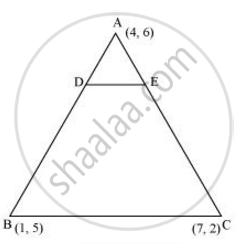Advertisements
Advertisements
प्रश्न
The vertices of a ΔABC are A (4, 6), B (1, 5) and C (7, 2). A line is drawn to intersect sides AB and AC at D and E respectively, such that `(AD)/(AB) = (AE)/(AC) = 1/4`Calculate the area of the ΔADE and compare it with the area of ΔABC. (Recall Converse of basic proportionality theorem and Theorem 6.6 related to ratio of areas of two similar triangles)
उत्तर

Given that (AD)/(AB) = (AE)/(AC) = 1/4
(AD)/(AD+DB) = (AE)/(AE+EC) = 1/4
(AD)/(DB)=(AE)/(EC) = 1/3
Therefore, D and E are two points on side AB and AC respectively such that they divide side AB and AC in a ratio of 1:3
Coordinates of Point D =`((1xx1+3xx4)/(1+3),(1xx5+3xx6)/(1+3))`
`= (13/4, 23/4)`
Coordinates of Point E =`((1xx7+3xx4)/(1+3), (1xx2+3xx6)/(1+3))`
`= (19/4, 20/4)`
Area of triangle =`1/2[x_1(y_2-y_3)+x_2(y_3-y_1)+x_3(y_1-y_2)]`
Area of ΔADE =`1/2[4(23/4-20/4)+13/4(20/4-6)+19/4(6-23/4)]`
`=1/2[3-13/4+19/16] = 1/2[(48-52+19)/16] = 15/32 `
Area of ΔABC =`1/2[4(5-2)+1(2-6)+7(6-5)]`
`= 1/2[12-4+7] = 15/2 `
Clearly, the ratio between the areas of ΔADE and ΔABC is 1:16.
Alternatively,
We know that if a line segment in a triangle divides its two sides in the same ratio, then the line segment is parallel to the third side of the triangle. These two triangles so formed (here ΔADE and ΔABC) will be similar to each other.
Hence, the ratio between the areas of these two triangles will be the square of the ratio between the sides of these two triangles.
Therefore, ratio between the areas of ΔADE and ΔABC =` (1/4)^2 = 1/16`
APPEARS IN
संबंधित प्रश्न
If A(−4, 8), B(−3, −4), C(0, −5) and D(5, 6) are the vertices of a quadrilateral ABCD, find its area.
If A(–5, 7), B(–4, –5), C(–1, –6) and D(4, 5) are the vertices of a quadrilateral, find the area of the quadrilateral ABCD
The vertices of ΔABC are (−2, 1), (5, 4) and (2, −3) respectively. Find the area of the triangle and the length of the altitude through A.
Show that the following sets of points are collinear.
(2, 5), (4, 6) and (8, 8)
For what value of a point (a, 1), (1, -1) and (11, 4) are collinear?
Prove that the points A(2, 4), b(2, 6) and (2 +`sqrt(3)` ,5) are the vertices of an equilateral triangle
If the area of triangle ABC formed by A(x, y), B(1, 2) and C(2, 1) is 6 square units, then prove that x + y = 15 ?
Using integration, find the area of the triangle whose vertices are (2, 3), (3, 5) and (4, 4).
In a triangle ABC, if `|(1, 1, 1),(1 + sin"A", 1 + sin"B", 1 + sin"C"),(sin"A" + sin^2"A", sin"B" + sin^2"B", sin"C" + sin^2"C")|` = 0, then prove that ∆ABC is an isoceles triangle.
The area of the triangle ABC with the vertices A(-5, 7), B(-4, -5) and C(4, 5) is ______.
